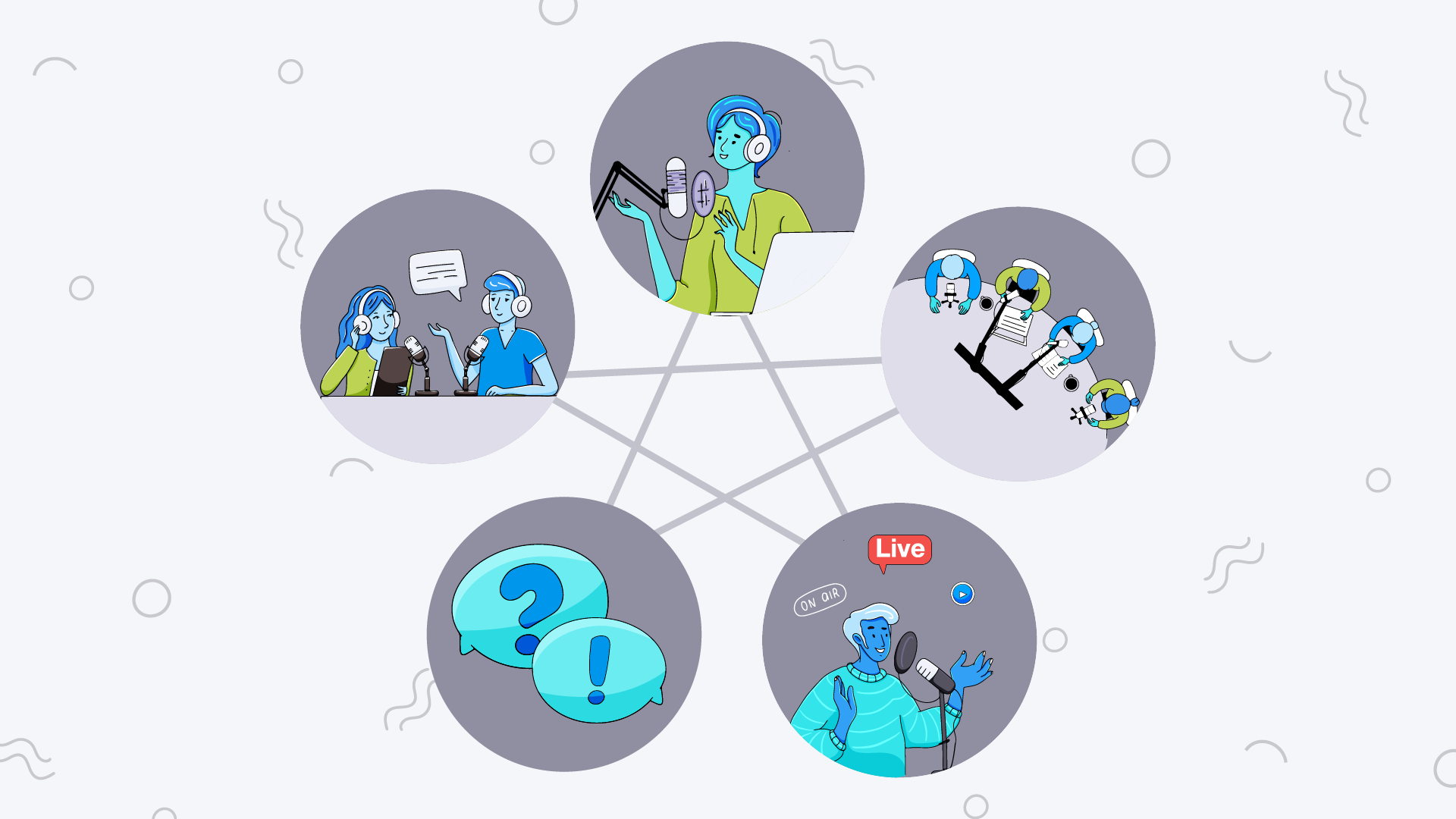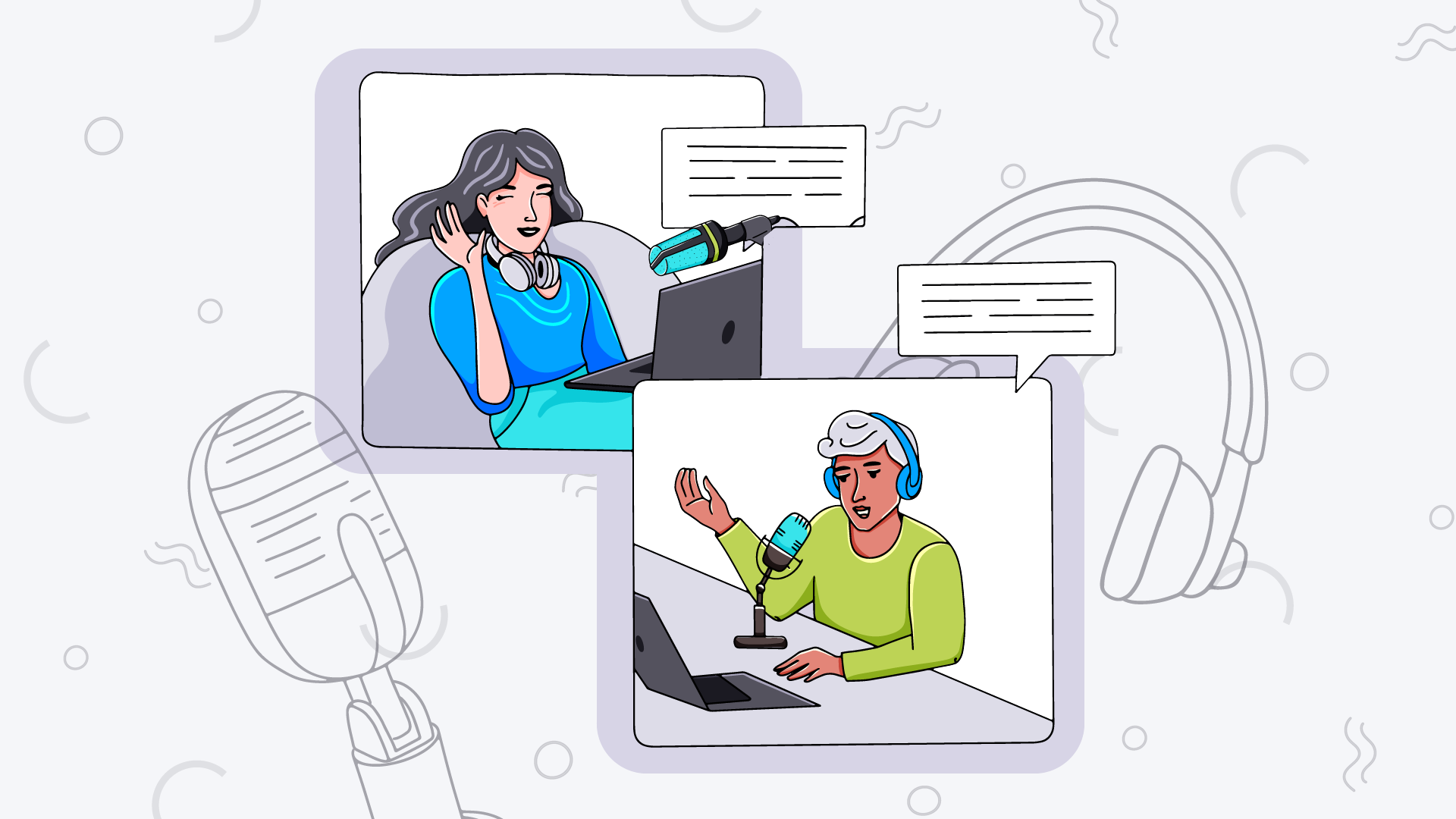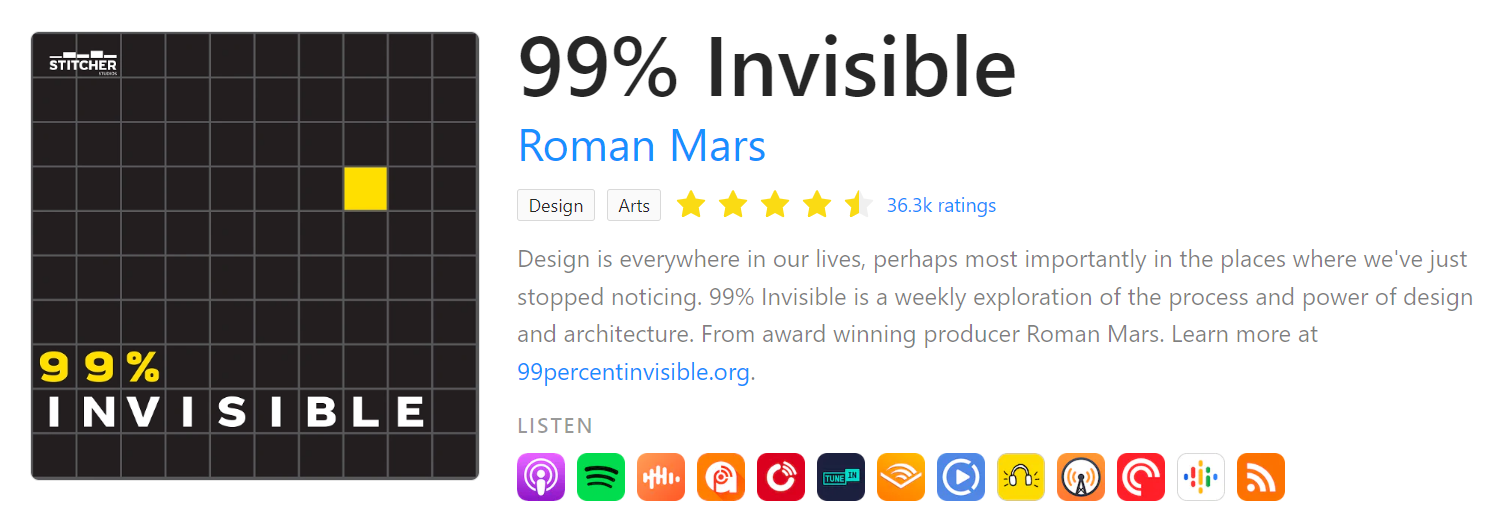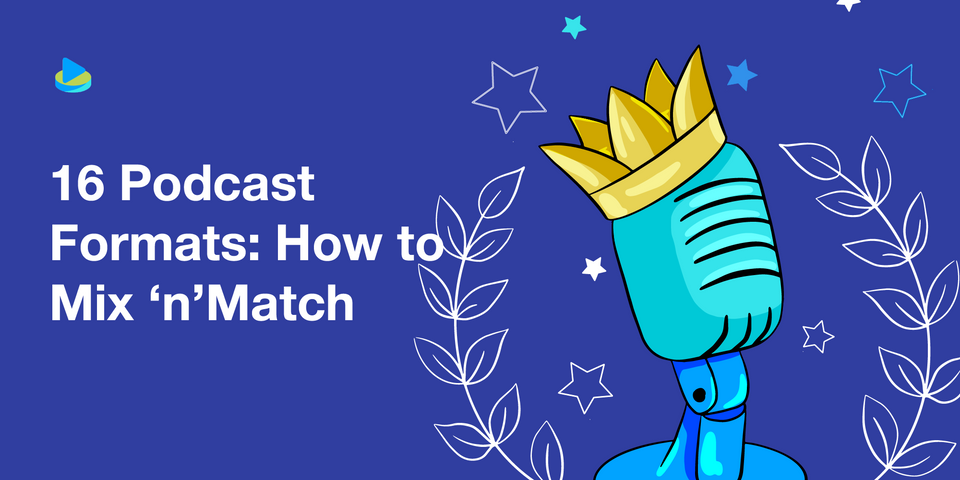How do I get my new podcast to stand out from the crowd? Surely the answer is to ignore all the popular podcast formats others use and create something unique?
Sorry, no!
The real answer is this: create a stand-out podcast by combining a unique blend of podcast formats + niche + your personality and style to entice fans in and keep them coming back for more.
Table of Contents
What is a podcast format?
A podcast format gives your show some structure and consistency. Contrary to what you might expect, podcast listeners like to know what to expect when they tune in to a podcast episode. While the content should change between episodes, following a familiar structure helps your listeners feel comfortable.
Following a standard podcast format helps you create a coherent flow between your episodes. It also helps you when planning because it's much easier to follow a pattern than to make something up from scratch each time.
Most successful podcasts have a basic episode structure, which is how you can create a flow within your episodes.
Each episode has:
- An intro with a hook to draw listeners in
- The main content which takes up most of the episode
- An outro that includes a CTA for ratings and reviews and perhaps a glimpse into the following episode.
Can you mix podcast formats?

Anything is possible within that overall structure, and combining formats helps make your podcast stand out. For example, podcast host Joanna Penn combines a solo podcast format with an interview. Each episode of The Creative Penn Podcast starts with a monologue covering industry news from the publishing world, updates on her own business and AI news, then continues with an expert interview.
Many podcast hosts alternate formats, e.g., Jay Acunzo's podcast switches between three formats. One episode of Unthinkable may be a monologue; another contains a story or creator advice, and the third is an expert interview. Mixing podcast formats can work so long as your audience knows what's happening and expects it.
So, what are the different podcast formats? Most podcasts follow one of these four: interview, solo podcast, panel interview, and conversational podcasts with two or more hosts to share the load. Let's look at what each podcast format entails, find some real-life examples and examine their pros and cons.
Four most popular podcast formats
1. Interview podcasts
The interview format is one of the most popular podcast formats around. In interview podcasts, the host talks to a different guest in each episode.
In many cases, these guests are industry experts in the podcast niche. However, they could also be fellow podcasters, storytellers, people who've had extraordinary experiences or life lessons, commentators, academics, comedians... the list of possibilities for podcast guests is almost endless.
If you need help coming up with tailored interview questions for your guest, why not try out our totally free podcast question generator?
Interview Podcast Example: The Great Creators with Guy Raz
In each episode of The Great Creators podcast, Guy Raz interviews guests like Tom Hanks, Alan Alda, Ellie Goulding and Sigourney Weaver, taking them deep into conversation about the events and people that have shaped their lives and careers.

The pros...
Interviewing a different guest in each episode brings new information and fresh perspectives to your podcast. It can also introduce your podcast to new listeners when the guest shares that episode with their own audiences.
...and cons.
However, it can take a lot of time and effort to find the many guests you need to keep the podcast going, especially if your podcast isn't well known. You'll also need to spend time researching each guest and deciding on relevant questions before you talk to them.
2. Solo podcasts
As the name suggests, solo podcasts don't involve guests or multiple hosts. There is just one host who creates rapport with their audience by talking directly to their listeners rather than conversing with a guest or co-host.
Solo Podcast Example: Strong Songs by Kirk Hamilton
Ever wondered why 'Stairway to Heaven' became a classic? What about 'I Will Always Love You' or 'Bohemian Rhapsody' draws you in and won't let go? In Strong Songs, podcast host Kirk Hamilton dissects the melodies, rhythms, harmonies and back stories behind a single song to explain how it weaves a spell over generations of listeners.

The pros...
Solo podcasts are terrific for creating a personal brand. Listeners come to feel they know and trust the host and tune in for that connection as much as for the content.
Solo podcasting means you can work to your schedule without worrying about anyone else's timetable. Editing is more straightforward, too, because it's easier to work with a single voice than with multiple tracks.
...and cons.
However, working by yourself can be rather lonely. You don't have anyone to bounce ideas off or to take some of the load. Moreover, speaking into a microphone can be tiring, and keeping up your intonation and energy for the whole episode is hard.
3. Co-hosted format
Co-hosted podcasts are sometimes called conversational podcasts because of the hosts' dialogue and relaxed banter.
Fans of this podcast format enjoy the organic conversation (as opposed to scripted monologues or Q&A discussions) and often feel part of a club rather than simply being in an audience.
Co-host podcast example: Chat 10, Looks 3 Podcast by Leigh Sales and Annabel Crabb
A whole ecosystem has developed around the Chat 10 Looks 3 podcast in the nine years since the co-hosts began to chat. Fans are called "Chatters." There's an active Chatter Facebook group, a semi-regular newsletter, weird and wonderful Chatter merch and links to an online bookshop to purchase the books discussed by the co-hosts. The podcast has also branched into different formats with multiple episodes performed live in theaters around Australia, a YouTube channel and a newly-launched spin-off book club podcast.

The pros...
Co-hosts can split the tasks associated with creating the podcast. Having each host work to their strengths while sharing the load makes podcast content creation easier and more fun.
...and cons.
Make sure you're on the same page as your co-host. It's essential to consider the podcast ownership structure, how you plan to fund it and how you'll allocate any revenue.
4. Roundtable format
The roundtable or panel podcast format involves a group of people in a discussion. The panel usually consists of one or two podcast hosts together with different guests on each episode. Some roundtable podcasts debate serious issues, while others feel like friends having a laugh.
Roundtable podcast example: The BeanCast Marketing Podcast
BeanCast is a weekly roundtable podcast in which a panel of experts joins podcast host Bob Knorpp to discuss recent marketing industry news and views.

The pros...
Conducting a roundtable or panel podcast allows you to present varied viewpoints on every episode. If you're lucky enough to host many industry experts, you'll also reinforce your standing within that niche or industry. It's also a great way to increase your network. You may also introduce people who haven't met before and are therefore seen as a connector in your industry or niche.
...and cons.
Editing multiple guests can be more complex and time-consuming than editing a solo episode with audio or video tracks, so even if you'd prefer to edit the podcast yourself, you may find it better to outsource a multi-track recording. Scheduling can also be a hassle. When you're trying to synchronize several people's calendars finding a date and time when everyone's available can be a nightmare.
Other styles to consider

The formats above are a great starting point. But you'll need to think even deeper to see what angle your podcast can take. How can you combine different podcast styles or audio elements to make your show stand out?
Here's one scenario. You're planning an interview podcast about mountain biking. So, will you interview your guests in a studio? Or could you possibly get outside and meet them in the mountains? Will you record the sounds of bikes heading down the mountain or keep the audio as speech only? You could even mix it up and alternate outside and inside episodes.
Then, consider the vibe. Will you have a serious interview podcast format or give it a comedic twist? Before you find the right podcast format for your unique show, there are many decisions to make. So, here are some examples of other types of podcast you might consider.
Storytelling or fiction podcasts
The fiction storytelling podcast format can be a storytelling podcast in a solo format, where one host or actor reads or narrates an entire story in each episode. Or it could be a story told in chapters across several weeks. The entire podcast could even be a full-blown serialized audio drama with multiple voice actors, music and sound effects.
Makeshift Stories is a bi-monthly sci-fi, fantasy, and speculative fiction podcast where you can hear a different original story in every episode.
The Black Tapes podcast is serialized docudrama with 51 episodes produced so far. Hosted by Alex Reagan. In the Black Tapes Podcast, the narrative follows one fictional journalist's search for the truth about her subject's mysterious past.

Non-fiction narrative/storytelling
99% Invisible is a compelling example of non fiction storytelling. The podcast blends storytelling and commentary with interview excerpts from the story's participants to weave together the tale of how one piece of everyday design can have a profound effect.

Top tip
Check our How to Promote Your Podcast article for 50+ marketing ideas.
On-the-ground podcast format
These types of podcasts are not recorded in a studio. Instead, the recording crew takes their equipment out and about - which could be anywhere. So long as you have the right equipment, you can record in the mountains, at events, in a classroom, or even on a fake planet.
The Habitat is recorded on a remote Hawaiian mountain, home to six volunteer "astronauts" spending a whole year in a simulated Mars environment. In this intriguing podcast, Lynn Levy chronicles the true story of this fake planet.

Live podcasts
Many established podcasts include episodes that have been recorded live where there is an audience listening in real time - often in theatres. A few podcasts are always recorded live, but most podcasters using this format are likelier to have studio recordings and live performances in their archives.
In the comedy podcast, How Did This Get Made? hosts Paul Scheer, June Diane Raphael and Jason Mantzoukas watch terrible movies with a group of their funniest friends and report back live with some hilarious results.

Investigative podcast format
Investigative podcasts follow the twisting tales of true crime mysteries, cold cases and even wrongful convictions. Some are limited editions, i.e., they follow a single case. Others, such as Serial, finish one saga and get straight onto the next.

Comedic podcast format
Comedy is one of the biggest genres in podcasting. Some podcasts are straight comedies, others are about comedy, and others contain comedic elements or humor.
For example, each Comedy of the Week episode features a different BBC Radio 4 comedy or stand-up show. On the other hand, You're Dead To Me is a history podcast in which Greg Jenner (from 'Horrible Histories') pairs a historian with a comedian to learn about diverse historical moments and adds a comedic twist to a serious subject.

Current affairs/news podcasts
Some people get news updates from television, while others read the paper or skim the news sites. But many also turn to news and current events podcasts for insights and analysis. These shows are usually brief and to the point.
The Daily is one well-known example of news podcasting and features the "biggest stories of our time, told by the best journalists in the world... Twenty minutes a day, five days a week."
NPR's Up First is another. It has "The three biggest stories of the day, with reporting and analysis from NPR News — in 10 minutes."

Immersive podcast format
An immersive podcast uses sound effects, voice actors and music to make the listener feel as if they're inside the story. Examples include The Polybius Conspiracy, which blends fact and fiction to tell the story of a mysterious arcade game from the '80s, and The Bright Sessions, which follows the fictional "therapy sessions for the strange and unusual" conducted by the equally interesting Dr. Bright.

Personal journal podcasts
Personal journal podcasts center on the host's personal thoughts, experiences, and reflections. It offers an intimate and authentic glimpse into the host's life, providing a sense of connection and often exploring personal growth or introspection.
In Happier with Gretchen Rubin, bestselling author Gretchen Rubin and her sister Elizabeth Craft share personal stories, discuss happiness-related topics, and provide practical advice as they explore strategies and insights for living a happier and more fulfilling life. And at the opposite end of the happiness scale, in 'Terrible, Thanks For Asking' author Nora McInerny talks to people about how they're really doing. It's sometimes sad, sometimes funny, and almost always both.

Lifestyle podcast
Lifestyle podcasts provide practical advice and inspiration to help listeners enhance their lives. Topics often include health, relationships, home organization, travel, personal development, fashion and beauty, and you'll find them in categories like Mental Health, Society & Culture, and Health & Fitness.
One example is The Minimalists Podcast, which discusses clutter and minimalism in many areas of life, including health, possessions, psychology, clothing, homes and even people. Another is The Tony Robbins Podcast, where Tony, his family, friends and guests share proven strategies and tactics for business, relationships, health and finances.

Host Q&As
In host Q&A podcasts, the host answers questions submitted by listeners or fans of the show. Hosts may dedicate a segment of each episode to Q&A or answer questions for the entire episode. The format is great for audience engagement and interaction. It fosters a sense of community and connection between the host and listeners and allows the host to share their knowledge and create a more interactive experience for their listeners.
Josh Spector has taken the somewhat unusual step of dedicating his entire I Want To Know podcast to the Q&A format. Listeners apply to ask Spector three questions to get his coaching advice about topics like newsletters, marketing, audience building and more.

Repurposed content
Some podcasts repurpose or adapt existing content from another medium into an audio format to take the content beyond your existing audience and introduce it to people who prefer listening over watching videos or reading blog posts.
Repackaging existing content is a great way to extend its lifespan and lets you create a podcast without spending too much time and effort creating brand-new content.
Repurposed content can include recordings of speeches given at live events, lessons from the creator's paid courses or webinars, audio tracks extracted from video content, or blog posts read as a podcast episode.
Some examples include the TED Radio Hour, which repurposes TED talks into audio episodes, and The Gary Vee Audio Experience, which includes business, marketing, and personal development content from the entrepreneur's keynote addresses, interviews, motivational talks and YouTube channels.

Final thoughts
So, let's return to your podcast format. Which of these is the right podcast format to enchant your target audience? How can you combine formats to create a stand-out show?
We've included a few podcast examples here to get you started but Rephonic lists the details and links to over two million podcasts in its database. So, for further inspiration, use each of these examples and head to the 3D graph to find similar podcasts.
Discover your podcast inspirations on Rephonic with our free 7-day trial.


